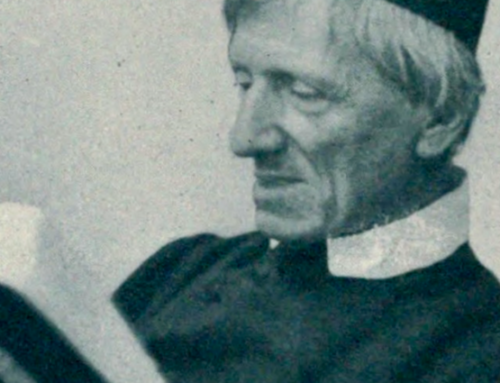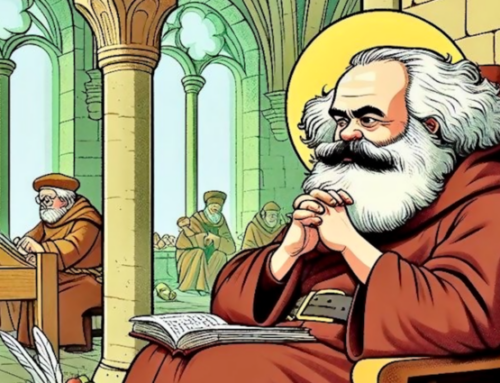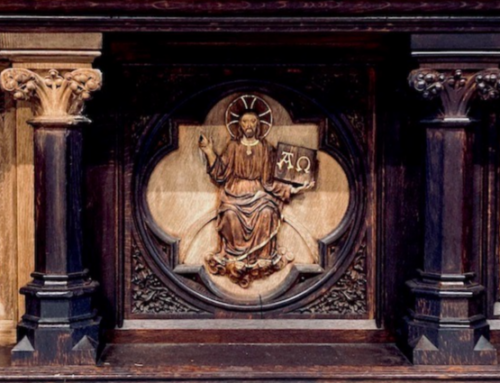The sheer power and magnitude of Wagner’s “Parsifal”—the fruit of his recent conversion to a vague form of Christianity—shook the resolve and philosophy of his long-time disciple, Friedrich Nietzsche, to their foundations.
 Having recently watched a superb and breathtaking performance of Wagner’s last and perhaps greatest work, I feel constrained to share some thoughts on the peace that Parsifal understands (pun intended!) and the seductive effect it had on Friedrich Nietzsche.
Having recently watched a superb and breathtaking performance of Wagner’s last and perhaps greatest work, I feel constrained to share some thoughts on the peace that Parsifal understands (pun intended!) and the seductive effect it had on Friedrich Nietzsche.
In spite of Parsifal’s theological quirkiness, which would disqualify it from receiving an imprimatur, it is profoundly Christian in the broad sense of the word. Parsifal passes from the innocent naiveté of Rousseau’s noble savage, via the temptation to fall and falter in the decadent quagmire of sin, to the fullness of the Christian embrace of self-sacrificial suffering and the redemptive healing and liberation that it brings.
Klingsor, unmistakably the satanic figure, wreaks havoc in his hard and heartless pride. Kundry, the truly tragic heroine, is the fruit of the furtive cross-fertilization of such fallen women as Herodias, Salomé, and Mary Magdalen. Transformed by her close encounter with Parsifal’s purity and chastity, Kundry emerges as a purgatorial saint, liberated from Klingsor’s luciferian clutches.
The sheer power and magnitude of Wagner’s achievement, the fruit of his recent conversion to a vague form of Christianity, shook the resolve and philosophy of Nietzsche to their foundations. The German philosopher had long been a disciple of Wagner and was shocked and horrified by the composer’s embrace of Christianity and by the Christian moral vision of Parsifal. And yet he couldn’t help but fall under its magical and graceful spell. He wrote of the work’s “loftiness in the most startling sense of the word, of a cognizance and a penetration of vision that cuts through the soul as with a knife, of sympathy with what is seen and shown forth. We get something comparable to it in Dante, but nowhere else.”
A month later, Nietzsche was again extolling the praises of Parsifal: “I cannot think of it without feeling violently shaken, so elevated was I by it, so deeply moved. It was as if someone were speaking to me again, after many years, about the problems that disturb me – naturally not supplying the answers I would give, but the Christian answer, which after all has been the answer of stronger souls than the last two centuries of our era have produced. When listening to this music one lays Protestantism aside as a misunderstanding – and also, I will not deny it, other really good music, which I have at other times heard and loved, seems, as against this, a misunderstanding!”
It seemed as though Wagner’s brilliance, inspired by his new-found Christianity, had “violently shaken” Nietzsche’s philosophical resolve, leading him perhaps to question whether his own philosophy was nothing but “a misunderstanding.” It was as though Nietzsche was being granted the grace to see the error of his ways and to repent. Instead, he allowed his pride to eclipse the brief vision of heaven that had been offered him by Wagner’s brilliance. In a long diatribe against Wagner, the philosopher of pride claimed proudly that he could resist the charm of the Christian Wagner: “In the art of seduction, Parsifal will always retain its rank – as the stroke of genius in seduction . . . One has to be a cynic in order not to be seduced here; one has to be able to bite in order not to worship here. Well, then, you old seducer, the cynic warns you – cave canem.” Thus, Nietzsche resorts to the sneer of the cynic and the bite of the beast as his means of keeping the genius of Wagner and the truth of the Church at bay. Within a year or so of writing these words, Nietzsche had a mental breakdown from which he never recovered. This is the tragedy of Nietzsche and the tragic consequence of Nietzscheanism, the latter of which would lead to the madness of Hitler, and the madness of today’s Pride movement.
As for Wagner, we learn from his wife’s diary that he “positively exploded in favour of Christianity as compared to racial theory” in an argument with the racist philosopher, Arthur de Gobineau. Wagner ended his life in harmony with the truth enunciated by the hero of his greatest opera. This is the happy ending of the divine comedy of his life. Although the peace that Parsifal understands is available to all who seek it, it eludes those who prefer the sneer of the cynic. It is a peace that is destroyed by the madness of proudly lupine philosophers who bark their lunatic insanities and inanities at the moon.
The Imaginative Conservative applies the principle of appreciation to the discussion of culture and politics—we approach dialogue with magnanimity rather than with mere civility. Will you help us remain a refreshing oasis in the increasingly contentious arena of modern discourse? Please consider donating now.
The featured image is “Parsifaland” (1910) by Rogelio de Egusquiza is in the public domain, courtesy of Wikimedia Commons.







Thank you for this- absolutely enlightening on so many levels! I often wondered if Nietzsche had been offered the gift of a return to the Christian truth.
While I truly appreciated this beautifully written review, I must take exception to two comments. First, regardless of Wagner’s latent Christian epiphany, he was an avowed anti-semite and unrepentant. Second, reading your credentials I was surprised you referred to Mary Magdalene as a “fallen woman”. Every clergyman of worth knows this was a grave error by Pope Gregory the Great in 1591.
Again, thank you for the beautifully written review. Something rarely seen today.
Respectfully,
Rev. Leonard Kalom
Certified Hospice Chaplain
Masters of Musicology
Northwestern University 1972
I have always thought Christianity was never at the top of Wagner’s priorities in this drama. It all too often seems like it is a blue print for aryan exceptionalism.
Parsifal looks past Christianity, indeed the name of Christ isn’t once mentioned in the entire libretto. Paraifal’s remorse of killing the swan is the turn. The truly Good Shepherd doesn’t kill the Lamb which is animated by the same living essence as inhabits man. Parsifal is Buddhist in its inspiration, albeit cloaked in Christian garb and embracing of certain ethical commonalities with Christianity.
Thank you Mr Pearce for that truly inspiring article! I definitely think Nietzsche was given a chance when presented with Wagner’s Parsifal, a chance to come to Christianity, but he unfortunately did not take it and wrote The Case of Wagner instead, which by the way I think is a very deprecating attack on Wagner and his philosophy, but also his art. Thank you for pointing out the beauty in Parsifal’s Christianity, and I do think like you it’s one of the greatest operas ever written, as much for art as for philosophy.
Readers wishing to read, and then study, Nietzsche’s response to Wagner’s Parsifal and thereby Christianity would need a citation to the striking passage in the Nachlass (leftovers) — (Colli/Montinari KSA XII, Nachgelassene Fragmente, Sommer 1886 Herbst 1887 5[41]) —- but those lacking German or a copy of the German edition itself would find such most conveniently in the work of the René Girard, who not only fixed attention on this struggle, but actually predicted this passage’s existence before discovering it. Best to start with would be Girard’s “Dionysus versus the Crucified,” Modern Language Notes, Vol. 99 (ca. 1984, No. 4), pp. 816-835. For more on Nietzsche’s struggle with Christ, including Girard’s searching examination of it, see my “René Girard and Nietzsche Struggling,” Proceedings of the Nietzsche Congress of 2006,
ed. Clemens Pornschlegel & Martin Stingelin (Berlin: Walter de Gruyter, 2009) pp. 351-375. As Romano Guardini wrote,
“such a breath of closeness blows through all of N’s struggle against Christ and Christianity that one cannot avoid the conclusion: he is turning against something which—he knows in his innermost heart—is good.”
Wagner spent the last winters of his life in the coffee shop across the square from San Marco’s in Venice. The stage plans from that period suggest that the extravagant splendor of the Cathedral was an inspiration for him. It might well be that had he and Cosima been able to marry in the Catholic church, they might have made their home there. It’s pretty clear that they disliked the Lutheran Church and detested the long, dull sermons they endured. Wagner loved beauty and there is no doubt that he would have learned to love the Lord of Beauty even more, though it would have been costly, at the price of his self-centeredness. But that is a price most of us have to pay in any case. Wagner was thinking about an opera about the Christ when he died. As a PS, I must add that to make antisemitism synonymous with Wagner is so tiresome. As though he were the only one! He was not to blame for the horrors of Hitler, and in fact, his SON, Siegfried, was already dead when the Beast came to power. It was, in fact, Siegfried’s widow, Winifred, not even a German, who was captivated by Hitler.
Ever since I watched Parsifal, I have believed it was a long Mass.
The late great conservative writer, Sir Roger Scruton, wrote a book-length defense of Parsifal which may be of interest to those who enjoyed this article.
And as if to prove the author’s point, there is a vitriolic “review” of the book and of the opera by an English Guardian writer, in which he apparently channels Nietzsche and unloads all manner of unhinged vituperative upon Sir Roger, conservativism in general, and Wagner in particular. In my mindset, any works which evoke such responses from “Guardianistas” is worth purchasing in multiple copies and giving to your friends!
Yes, we have a review of Roger’s book here: https://theimaginativeconservative.org/2020/06/swan-song-roger-scruton-wagner-parsifal-music-redemption-paul-krause.html